St
John's Hospital for
Diseases of the Skin
Diseases of the Skin
5 Lisle Street, Leicester Square, WC2H
7BJ
Medical
dates:
Medical
character:
Specialist
Founded in 1863 at No. 12 Church Street (now
Romilly Street), Soho, by the surgeon John Laws
Milton (1820-1898), the St John's Hospital for Diseases of the Skin moved
to various locations
within Soho during the early 20th century.
From 1865 to 1887 the hospital was at 45 Leicester Square. Clinics were held daily in the afternoons (in the previous locations the medical officer had attended only once a week). Once a week an evening clinic enabled the 'artisan classes' to attend 'without it being known that they are afflicted with a skin disease' and thus avoiding dismissal from their employment. During the late 1860's the hospital began to take in-patients, and usually had about a dozen beds. The number of new out-patients gradually increased from 1,442 in 1876 to 4,298 in 1886, while from 1883 to 1886 seventeen beds were available for in-patients at an annexe at No. 17 Markham Square, Chelsea.
In 1886 the lease for 45 Leicester Square expired. The annexe in Chelsea was closed and in 1887 both in-patients and out-patients moved to 49 Leicester Square. The spacious accommodation had an extensive basement, and the rooms were light and airy.
In February 1896 in-patient wards opened at Arlington House, 262 Uxbridge Road, in Hammersmith. There were 40 beds.
By the beginning of the 20th century the Hospital was treating nearly 8,000 new patients a year and in 1905 the Out-Patients Department at 49 Leicester Square was rebuilt. Completed and equipped at a cost of just over £10,000, it was deemed spacious enough to meet all future demands upon it in the years to come.
This was not to be and, by 1934 when 54,453 out-patients were being treated, it was decided that the existing accommodation was completely inadequate. The Hospital management committee purchased 5 Lisle Street, a house in the red light district of Soho, for £25,000. Alterations began to the building in the summer of 1935, estimated to cost £8,000, and the Hospital moved in at the end of the year.
The new premises opened to patients on 1st January 1936. The building had been so planned that the patients - some 1,000 a week, could be dealt with rapidly. By 1938 the number attending had risen to 65,798.
During WW2 the Uxbridge Road in-patients department was severely damaged by bombing and forced to close in 1940.
In 1948 the Hospital joined the NHS as one of the 14 postgraduate teaching hospitals.
In 1950 the Hospital was extended northwards over the sites of 28 and 29 Gerrard Street.
In 1952 St John's Hospital took over available ward space in the disused part of the Eastern Hospital in Homerton, eight miles away. Additional wards and laboratories were opened during the following decade and, by the 1960s, the Hospital had 60 beds (today there are less that 50 designated dermatology beds in the whole of London).
The Westminster General Dispensary, No. 9 Gerrard Street, was rented by the Hospital from 1954 to 1962. In 1962 the Hospital also took over No. 30 Gerrard Street, while contemplating moving to the proposed Postgraduate Centre of Hospitals and Institutes at Chelsea (this project was never developed).
The Institute of Dermatology, a member of the British Postgraduate Medical Federation, funded by the University of London, was also based in Lisle Street and at the Eastern Hospital. Following the Flowers' Report in the early 1980s, which recommended that smaller postgraduate institutes and their associated hospitals amalgamate, the Hospital and Institute were advised to relocate to the St Thomas' Hospital campus.
The move, which was spread over two years, began in 1987 with the in-patients and the Institute departments at the Eastern Hospital relocating to refurbished premises at St Thomas' Hospital and culminated with the Lisle Street premises being vacated in 1989.
From 1865 to 1887 the hospital was at 45 Leicester Square. Clinics were held daily in the afternoons (in the previous locations the medical officer had attended only once a week). Once a week an evening clinic enabled the 'artisan classes' to attend 'without it being known that they are afflicted with a skin disease' and thus avoiding dismissal from their employment. During the late 1860's the hospital began to take in-patients, and usually had about a dozen beds. The number of new out-patients gradually increased from 1,442 in 1876 to 4,298 in 1886, while from 1883 to 1886 seventeen beds were available for in-patients at an annexe at No. 17 Markham Square, Chelsea.
In 1886 the lease for 45 Leicester Square expired. The annexe in Chelsea was closed and in 1887 both in-patients and out-patients moved to 49 Leicester Square. The spacious accommodation had an extensive basement, and the rooms were light and airy.
In February 1896 in-patient wards opened at Arlington House, 262 Uxbridge Road, in Hammersmith. There were 40 beds.
By the beginning of the 20th century the Hospital was treating nearly 8,000 new patients a year and in 1905 the Out-Patients Department at 49 Leicester Square was rebuilt. Completed and equipped at a cost of just over £10,000, it was deemed spacious enough to meet all future demands upon it in the years to come.
This was not to be and, by 1934 when 54,453 out-patients were being treated, it was decided that the existing accommodation was completely inadequate. The Hospital management committee purchased 5 Lisle Street, a house in the red light district of Soho, for £25,000. Alterations began to the building in the summer of 1935, estimated to cost £8,000, and the Hospital moved in at the end of the year.
The new premises opened to patients on 1st January 1936. The building had been so planned that the patients - some 1,000 a week, could be dealt with rapidly. By 1938 the number attending had risen to 65,798.
During WW2 the Uxbridge Road in-patients department was severely damaged by bombing and forced to close in 1940.
In 1948 the Hospital joined the NHS as one of the 14 postgraduate teaching hospitals.
In 1950 the Hospital was extended northwards over the sites of 28 and 29 Gerrard Street.
In 1952 St John's Hospital took over available ward space in the disused part of the Eastern Hospital in Homerton, eight miles away. Additional wards and laboratories were opened during the following decade and, by the 1960s, the Hospital had 60 beds (today there are less that 50 designated dermatology beds in the whole of London).
The Westminster General Dispensary, No. 9 Gerrard Street, was rented by the Hospital from 1954 to 1962. In 1962 the Hospital also took over No. 30 Gerrard Street, while contemplating moving to the proposed Postgraduate Centre of Hospitals and Institutes at Chelsea (this project was never developed).
The Institute of Dermatology, a member of the British Postgraduate Medical Federation, funded by the University of London, was also based in Lisle Street and at the Eastern Hospital. Following the Flowers' Report in the early 1980s, which recommended that smaller postgraduate institutes and their associated hospitals amalgamate, the Hospital and Institute were advised to relocate to the St Thomas' Hospital campus.
The move, which was spread over two years, began in 1987 with the in-patients and the Institute departments at the Eastern Hospital relocating to refurbished premises at St Thomas' Hospital and culminated with the Lisle Street premises being vacated in 1989.
Present status (December
2007)
The building is now a public house - the Crooked Surgeon.
Update: October 2014
The building is now a restaurant and bar - the Slug and Lettuce.
The building is now a public house - the Crooked Surgeon.
Update: October 2014
The building is now a restaurant and bar - the Slug and Lettuce.
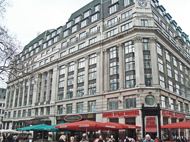
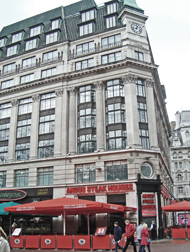
No. 49 Leicester Square was the site of the Hospital at the beginning of the 20th century. The building was once the Automobile Association headquarters and is now the Communications Building.

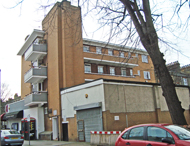
The in-patients site at Arlington House, 262 Uxbridge Road, has been redeveloped and now contains a supermarket with apartments above (left). Arlington House is now two new apartment blocks in Tunis Road, off Uxbridge Road. The southern block with the supermarket, as seen from Tunis Road (right).

The northern block of Arlington House in Tunis Road.
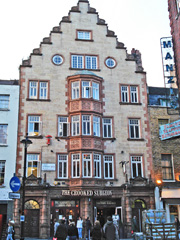
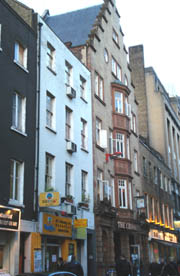
The gabled frontage of No. 5 Lisle Street in the early Renaissance style of northern Europe (left) was built in 1897. The old Hospital building with its neighbours in Lisle Street (right).

'The Crooked Surgeon' public house.
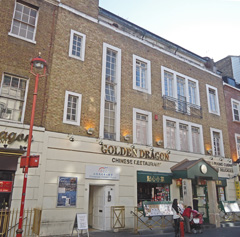
Nos. 28-29 Gerrard Street, part of the Hospital's 1950s extension, are now the Golden Dragon.
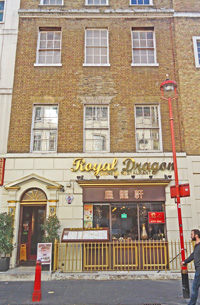
The building next door, No. 30 Gerrard Street, taken over in 1962, is now the Royal Dragon.
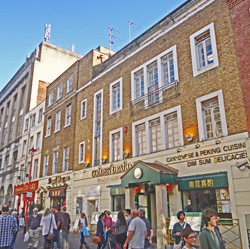
Today Gerrard Street is the centre of London's Chinatown.

No. 9 Gerrard Street, once the site of the Westminster General Dispensary and rented by the Hospital from 1954 to 1962, is now the New Loon Moon Supermarket.
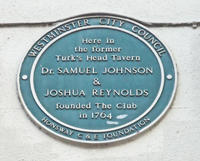
A blue plaque on the wall commemorates No. 9 as once the site of The Club, founded by Dr Samuel Johnson and Joshua Reynolds in 1764 in the former Turk's Head Tavern.
Update: October 2014
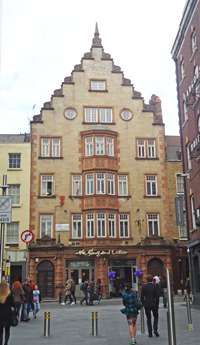
The former Hospital building is now The Slug and Lettuce.
(Author unstated) 1896 Reflections from a board room mirror. Nursing Record and Hospital World, 22nd February, 155.
(Author unstated) 1963 London Skin Hospital's Centenary. British Medical Journal 1 (5339), 1220.
Black N 2006 Walking London's Medical History. London, Royal Society of Medicine Press.
Russell B (ed) 1963 St John's Hospital for Diseases of the Skin 1863-1963. Edinburgh, E & S Livingstone.
Samman PD 1990 A History of St John's Hospital for Diseases of the Skin 1963-1988. Oxford, Radcliffe Medical Press.
www.nationalarchives.gov.uk
www.aim25.ac.uk
www.british-history.ac.uk
www.kcl.ac.uk
Return to home page